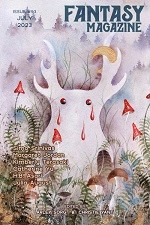“The World is Ending Tomorrow” by Kimberly Terasaki
“Bozpo Witch-Bane” by Simo Srinivas
“The Dancer” by Catherine Yu
“Blue” by Margaret Jordan
Reviewed by Victoria Silverwolf
Four short stories appear in this issue.
“The World is Ending Tomorrow” by Kimberly Terasaki is a very brief account of how people react when entire cities vanish one at a time. This tiny work considers living for today versus planning for tomorrow. It is best thought of as a philosophical meditation rather than as a fully developed story.
The narrator of “Bozpo Witch-Bane” by Simo Srinivas is a cat. She accompanies another cat who is intent on killing a witch, but has her own reasons for the journey. After a sea voyage and a series of transformations, the narrator’s past comes to light.
The author does a good job writing from the point of view of an animal, and the story is full of magic that should appeal to readers of fantasy. I have to admit that a certain event left me a bit confused, even for a tale set in an imaginary world where almost anything is possible.
A footnote makes it clear that “The Dancer” by Catherine Yu is based on Hans Christian Andersen’s famous story “The Red Shoes.” The narrator witnesses a ballerina suffer the same fate described in that well-known tale. This very short work is most notable for its vivid description of the physical pain suffered by professional dancers. Otherwise, it adds little to its inspiration.
In “Blue” by Margaret Jordan, a woman living in Southern California barely survives a devastating fire by fleeing to the ocean. Severely traumatized by the incident, she moves to New Mexico in an attempt to escape her crippling fear of the sea. Three new friends aid her healing process.
I have not mentioned the fantasy aspects of the plot because they are far in the background, adding a touch of magic realism or surrealism to what is otherwise a work of mainstream fiction. The woman produces seawater from her body, and another character produces ice.
Narrated in an introspective, sometimes stream-of-consciousness style, this story strives to be serious literature rather than genre entertainment. Some readers may find it overwritten. The author has a gift for characterization, which is the strongest aspect of a tale that might be better without its fantasy content.
Victoria Silverwolf notes that one of these stories is longer than the other three combined.
 Fantasy
Fantasy